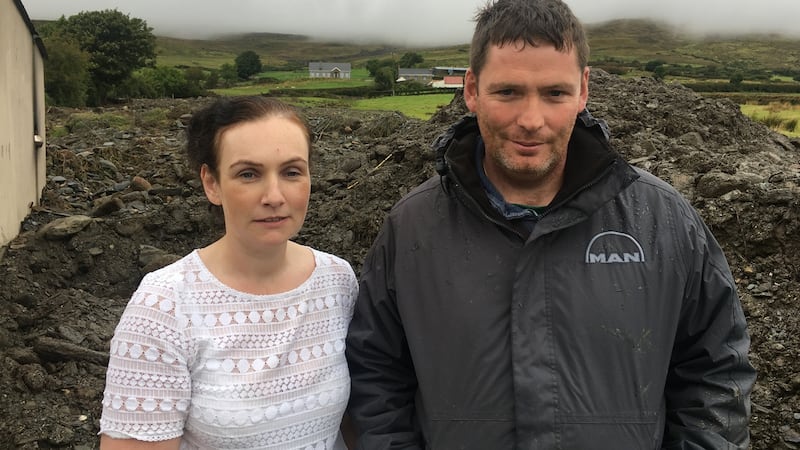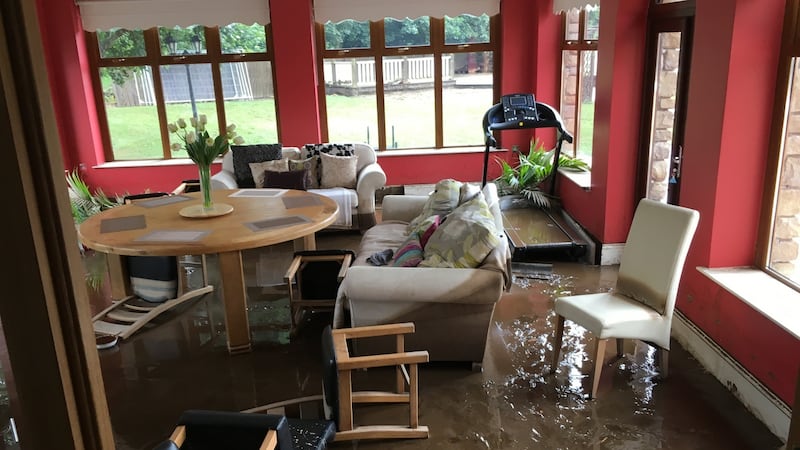The Gallagher family were in their living room when the mountain behind them began to move, but they had no idea what was going on.
Their home is a modest, single-storey cottage built about 40 years ago by Gerard Gallagher's father. At the back of the house, which sits on a slope beneath the 484m mountain locals call Scalp Hill, there are some concrete outhouses running the length of the home. It was these that saved the family.
On Tuesday at about 8pm the heavens opened, and it poured rain with an intensity that no one had ever experienced before.
Soon, high above the Gallagher home, the hill began to slide.
“I was in the house, and a cousin of mine came running down – ‘look at the hill; the trees is coming! Get those cars moved,’ he shouted. So I jumped in and took a chance,” truck driver Gerard recalled this week standing amid the debris of what careered down the mountain and just missed his moved car.
He was lucky, very, very lucky, as were his children Kyle (5), Noah (3), Evie (six months), and their mother Jacqueline, Gerard’s wife.
That no one died from the floods that engulfed the southern part of Donegal's Inishowen peninsula – from Quigley's Point on Lough Foyle in the east, across to Buncrana facing Lough Swilly in the west, and south to the town of Burnfoot – is remarkable.
The avalanche of water, mud, gravel and boulders that slithered off Scalp Hill – moving at the pace of a jogger – brought several hundred tonnes of debris crashing towards the Gallagher home. The sheds at the rear split the flow in two, forcing it to pass on either side of the house.
Boulders and mud
What was left when it ended was a mass of debris, behind and on either side of the house, and out front where the avalanche smashed through a hedge and removed a sturdy garden retaining wall, a huge scattering of boulders and mud.
“I could see the rocks coming at us,” says Gerard, “and I didn’t know whether we should run or stay, but we stayed.”
Neighbours, whom the Gallaghers cannot thank enough for being there for them and helping with the clean-up, ran to the house and thought they would find the worst.
“We were very unlucky, but we were very lucky at the same time,” says Gerard, describing Scalp Hill as “the mountain that moved that never moved before”.
While much of the heavier debris came to a halt at and around the Gallagher home, the water flowed on down the hill towards Birdstown and the Burnfoot river in the glen below – where Paul Bradley’s home was in the way.
The Bradley home is a substantial, six-bedroom house which Paul built eight years ago. It sits on the bank of the normally small Burnfoot river. When not project managing on a site north of London, Paul lives there with wife Lorraine and children Emily (10), Charlie (8) and Alex (3).
They were away when the flood occurred, but Paul returned and tried to save some furniture. Did he save anything?
“No,” he said, resigned, “nothing.”
Today the ground floor of a house that would fit many people’s definition of a dream home is smothered in a smelly, brown glistening sludge. A high-water mark can be seen four feet up every internal wall. Furniture is scattered about.
Outside the garden is wrecked. The wall that ran along the side of the road that became a surging river has collapsed onto the lawn.
Repairs
Triangular metre-long coping stones that topped off the wall have been swept 50ft into the garden, yet they are too heavy for a man to lift.
Paul reckons it will cost €150,000 to €200,000 to repair the property. He has insurance but is unlikely to get it again, and is not sure whether the property has a future.

It was built on a floodplain and has been flooded before – “three or four times but nothing like this”, says Paul. There is a flood barrier across the entrance gates but it was too low to stop what came at it for five hours on Tuesday.
“I didn’t know [it was a floodplain],” he says, “but I know now. I’m not from here, but the council shouldn’t have let me build here. One hundred per cent. That’s the whole reason for planning permission. I do feel I was let down because they let me build on a floodplain.”
The Burnfoot river flows on through the glen, and is fed by at least four more streams coming off Scalp Hill. On the edge of Burnfoot village the river – by Tuesday night a raging torrent – comes to a cluster of 12 council homes, Páirc An Grianán, built around 2001/2002.
They are also on a floodplain, a fact obvious by the topography: the entrance from the R239 Muff to Burnfoot road falls steeply down to the river. Beside the small estate is a water-treatment plant.
Gerard Duffy lives with his wife and four children in one of the houses nearest the road, and is, therefore, more elevated than the others. Yet the flood waters lapped his front door.
“We never thought we’d see water up this far,” he said, surveying the mounds of carpets outside homes and skips filled with destroyed furniture.
Collapsed it
The road from Muff to Quigley’s Point, the R238, runs alongside the Foyle, and is a fine modern road. Yet water poured off Scalp Hill in such a volume and at such speed on Tuesday that, instead of flowing under the road, it collapsed it by gouging at least one hole large enough for an articulated lorry to disappear into.
Council staff and contractors worked through the rain on Thursday trying to cordon off the sink hole and make the road passable.
To get to Buncrana from that side of the Inishowen one can drive up and through Grainne’s Gap, sandwiched between Scalp Hill and Eskaheen (418m), and down to the Swilly. Up there, among the upland bog, commonage and heather, there are more massive landslides, and diggers work to make the way passable again.
What happened up there caused little permanent damage but down below, in Buncrana itself, the Crana river became a monster.
It enters the sea through a small gorge, perhaps 40ft or 50ft deep, running through Swan Park, a beautiful nature preserve and walking area donated to the town in 1965 by local businessman Harry Swan.
The entrance to the park at the mouth of the river is known as Wilson’s Bridge, a very long-standing stone bridge that stood high above the river. It stands no more.
Beside it a huge concave lump has been gouged from the riverbank as though a giant bit into it as if it was an apple.
Local playing field
Upstream, Cock Hill Bridge, a lovely three-arch stone bridge standing 25ft to 30ft above the usual flow of the Crana, became a barrier as debris massed against the pillars.
The water just flowed over the bridge – something no one living locally had ever seen before – pouring into a local playing field, and raging on down towards Swan Park.
Upstream from Cock Hill Bridge, at the small estate of Elm Park, Treacy Kelly tried to flee her home, a two-storey house closest to the Crana. She fell over into the water flowing around her house.

Annette Doherty, perched 15ft above the river but still flooded (a neighbour's 1,000-litre oil tank came to rest outside her place), explains how Treacy was saved. "Neighbours formed a human chain to reach her, and someone drove a car into the river to block the flow."
The Burnfoot river that flows into Lough Swilly shortly after passing through its namesake village must first enter a man-made lake, Inch lake, before reaching the sea. The story of the lake, which some local people think contributed to the flooding on the southern and eastern parts of the peninsula, goes back to the middle of the last century and a Derry-based businessman.
Piece by piece he bought 3,000 acres in an area known as the slab, a low-lying place south of Burnfoot and west of today's N13 Letterkenny to Buncrana road. With the help of Dutch engineers he built dams between his land and Inch island, creating a lake and sacrificing 500 acres of his land but into which he was able to drain the remaining 2,500 acres.
The road from Burnfoot to the lake is known as the Watery Road, a clue, surely, to something?
High tide
At low tide sluice gates in the lake dam wall open, allowing the lake to drain. But on Tuesday night, with a high tide and unprecedented rain, the lake could not cope, and the water backed up along the Burnfoot river.
"The lake is now a wildlife sanctuary and it hasn't been dredged for years," says local man John Logan. "It's silted up, and it just can't take as much water as it used to."
Landslides, possibly related to climate change, have been witnessed in Ireland before, notably in Galway and Mayo. Hydrologists, engineers and climate scientists have identified drying of upland bogs to the extent that surface material shrinks and detaches itself from the hillside, allowing water to flow under the material, causing it to slide.
Is this what happened on Scalp Hill – a man-made “natural” disaster, with consequences made worse by people building where they should not, and blocking the flow of a river into the sea?
The damage to roads, and not just the massive sink holes that have appeared on significant roads but lesser roads whose sides have been eroded and are in many instances already sinking into ditches, will take time and money.
Money almost certainly beyond the means of Donegal County Council.










